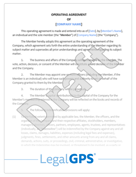Should Social Media Managers Use a Client Contract?
Imagine this: You’re a social media manager who just launched a killer Instagram campaign for a client. The posts are racking up likes, but when you...
6 min read
LegalGPS : Jun. 27, 2025
Picture this: You’re a photographer wrapping up a stunning brand shoot for a local business. The images are perfect, and the client uses them in a national ad campaign. Then, out of nowhere, the model sues you and the brand for $10,000, claiming they never agreed to commercial use of their likeness. Your heart sinks—could this tank your career? This scenario is why every photographer and brand manager needs a model release for brand shoots. This simple document can protect you from lawsuits, clarify usage rights, and ensure everyone’s on the same page.


Legal GPS Pro
Protect your business with our complete legal subscription service, designed by top startup attorneys.
So, should you use a model release for brand shoots? Absolutely. Whether you’re shooting for social media ads, product campaigns, or corporate branding, a model release is your safeguard against legal disputes and privacy claims.
In this guide, we’ll explore what a model release is, why it’s essential for brand shoots, the key elements to include, when to use one, and how to create your own. With real-world examples and actionable pro tips, you’ll learn how to protect your photography business and deliver professional results. Let’s get started.
A model release is a legal document signed by a model (or their guardian, for minors) granting permission to use their likeness—photos, videos, or other media—for specific purposes, such as commercial brand campaigns. It protects photographers, videographers, and brands by ensuring the model consents to the use of their image and waives their right to sue for privacy or publicity violations.

Model Consent and Release
Obtain our Model Consent and Release Contract Template to secure your photoshoots. Ensure legal protection and clear terms with models.
Trusted by 1,000+ businesses to safeguard their LLCs.
For brand shoots, where images are often used in high-stakes marketing (e.g., billboards, social media, or product packaging), a model release for brand shoots is critical. Without one, you risk lawsuits, financial penalties, or having to pull a campaign, which can cost thousands and damage your reputation. A release also clarifies expectations, ensuring models understand how their image will be used, which builds trust and professionalism. It’s not just about avoiding legal trouble—it’s about running a sustainable creative business.
Meet Alex, a photographer hired for a clothing brand’s photoshoot. The images feature a model in various outfits, and the brand uses them in a nationwide ad campaign. The model, unaware of the commercial scope, sues Alex and the brand for $15,000, claiming unauthorized use of their likeness. Without a signed model release, Alex faces costly legal fees and a damaged client relationship. A release specifying commercial use would have dismissed the lawsuit, protecting Alex and the brand.
Don’t draft from scratch. A customizable model release template from Legal GPS is attorney-drafted and tailored for brand shoots. It covers all the essentials, saving you time and ensuring your release is legally sound.
A strong model release form for photography is your defense against legal and professional pitfalls. Here are the must-have elements to include:
These elements address the biggest risks in brand shoots, from privacy claims to unauthorized use. Check state-specific laws, as some states (e.g., California, New York) have stricter rules on rights of publicity and may require specific wording.
Sarah, a videographer, shoots a promotional video for a fitness brand featuring a model. The brand later uses the footage in a global TV ad, beyond the agreed social media scope. The model demands $5,000 for unauthorized use. Sarah’s model release limited usage to “social media platforms for one year,” allowing her to negotiate a new licensing fee and avoid a lawsuit. Without the release, Sarah and the brand would have faced legal and financial consequences.
Clearly define how images can be used (e.g., “Instagram and Facebook ads only, no print or TV”) and for how long (e.g., “12 months from shoot date”). This prevents models from claiming misuse and protects you and your clients from disputes.
You might think model releases are only for big-budget campaigns or professional models, but that’s a myth. A model release is critical in these scenarios:


Legal GPS Pro
Protect your business with our complete legal subscription service, designed by top startup attorneys.
Some photographers believe myths like “Verbal consent is enough” or “Releases aren’t needed for non-commercial shoots.” In reality, verbal agreements are hard to prove, and even “editorial” shoots can become commercial if used in marketing later. A release also builds trust with models and clients, showcasing your professionalism and encouraging repeat business.
Jake, a photographer, shoots a lifestyle session for a coffee shop, intending the images for their website. The shop later uses a model’s image in a paid Instagram ad without a release. The model files a privacy claim for $3,000, arguing they didn’t consent to commercial use. A signed model release specifying potential commercial use (e.g., “online marketing”) would have prevented the dispute and protected Jake’s reputation.
Require a model release for any shoot that might be used commercially, even if the intent is unclear at the time. This covers unexpected uses (e.g., a client repurposing images for ads) and ensures you’re protected from the start.
Creating a brand shoot model release is easier than you think. Follow these steps:
When presenting the release, frame it as an industry standard: “This release ensures we can use the images as planned while protecting everyone involved.” This approach minimizes pushback and reassures models.
Emma, a photographer, started using a Legal GPS model release for all brand shoots. For a recent skincare campaign, she sent a release specifying “use in social media and website ads for two years.” The model signed via DocuSign, and the brand was impressed by Emma’s professionalism, booking her for two more shoots. The release protected Emma legally and boosted her reputation as a trusted creative.
Streamline your process with e-signature tools like DocuSign or HelloSign. These platforms let models sign releases digitally, save time, and keep your records organized for legal or tax purposes.
Even seasoned photographers can stumble with model releases. Here are common pitfalls and how to avoid them:
Legal GPS templates are designed with clear, state-compliant language to sidestep these issues, but review your release annually or for major shoots.
Tom, a videographer, used a model release for a brand shoot but vaguely stated “use in marketing materials.” The brand used the footage indefinitely on global TV ads, upsetting the model, who demanded $7,000 for unauthorized use. A release with specific usage (e.g., “social media ads for 12 months”) and duration limits would have prevented the dispute and ensured fair use.
For shoots involving minors, use a separate model release signed by a parent or guardian. Include language specifying the guardian’s authority to consent, ensuring the release is legally binding and compliant with state laws.
A model release for brand shoots is more than a formality—it’s a cornerstone of a professional photography or branding business. By securing model consent, clarifying usage rights, and protecting against lawsuits, it ensures your creative work can shine without legal risks. Whether you’re shooting for social media, print ads, or product campaigns, a model release keeps you, your clients, and your models on the same page.
The biggest question now is, "Do you need a lawyer for your business?” For most businesses and in most cases, you don't need a lawyer to start your business. Instead, many business owners rely on Legal GPS Pro to help with legal issues.
Legal GPS Pro is your All-In-One Legal Toolkit for Businesses. Developed by top startup attorneys, Pro gives you access to 100+ expertly crafted templates including operating agreements, NDAs, and service agreements, and an interactive platform. All designed to protect your company and set it up for lasting success.

Legal GPS Pro
Protect your business with our complete legal subscription service, designed by top startup attorneys.
|
Premium Template
Single-use Template |
Legal GPS Pro
Unlimited Access, Best Value |
|
|
| Choose Template | Learn More |
| Trusted by 1000+ businesses | |
Table of Contents

Imagine this: You’re a social media manager who just launched a killer Instagram campaign for a client. The posts are racking up likes, but when you...

You’ve just poured weeks into crafting perfect website copy for a client. You hit send, expecting praise and payment. Instead, the client demands...

You’ve just delivered a 15,000-word translation of a legal contract, expecting prompt payment for weeks of meticulous work. Instead, the client...